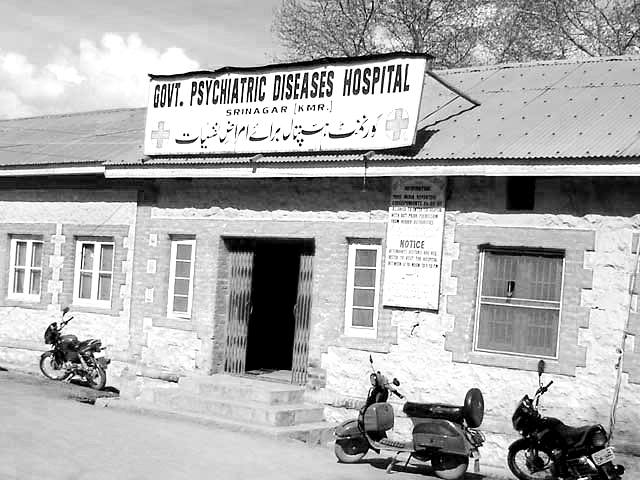by Maroosha Muzzaffar

The lone mental health care hospital in Kashmir lacks a rehabilitation centre, a facility psychiatrists insist is essential for chronic patients. This is despite a rapidly rising number of psychiatric patients. Around 50,000 patients visited the hospital last year.
The absence of the rehabilitation centre, doctors say, limits treatment and most of the severe cases return home with only a ‘part’ of the treatment. “Seventy to 80 percent of patients admitted to this hospital get well and are sent back home. But some patients don’t respond to the treatment,” says Dr Arshad Hussain, a doctor at the Government Psychiatric Diseases Hospital in Srinagar. “It is for such patients that rehabilitation process is a must.”
Rehabilitation centre works towards the overall betterment of severe mental illness cases like schizophrenics and helps patients get fit enough to be sent back to the community. These centres employ occupational therapists and psychiatric social workers who play an important role in the rehabilitation process.
“The rehab process is important for chronic patients – those who spend more than six months each year in the hospital and those who show extreme sings of disorder,” says Dr Hamidullah Shah, Medical Superintendent of the Psychiatric Disease Hospital.
While the rehabilitation centre has not come up, manpower available for the job lacks training. “Our hospital has a few posts for occupational therapists and psychiatric social workers, but they lack the required training,” says Dr Hussain.
The psychiatric social worker’s job is to garner social support for the patients. The worker remains in constant touch with the victim’s family and friends and helps them understand the nuances of patient’s ailments. At times they also try and find suitable jobs for them. Many patients at the hospital show considerable improvement in their condition, but their families refuse to take them back. “The refusal is because of lack of understanding of their disease. This leaves the patients in the lurch,” said Dr Hussain.
Staying back at the hospital, the patients develop “secondary deficits” in the wards due to isolation. Even for those who return to home, coping up social pressures and adjusting in peer groups often proves difficult.
“If the patient and his family are unable to adapt to each other, the disease can recur in the patients,” says Dr Hussain.
It is these problems that make the rehabilitation centre a must.
“Occupational therapists teach various skills like basket-making, tailoring and candle-making to the patients to keep them busy. The activity also enhances the patient’s self-esteem,” says Dr Hussain. “The idea is to divert their (patients’) thoughts from self and illness to other stimuli around them.” Prof Shah says that the hospital is unable to provide any such treatment unless the Social Welfare Department chips in. “Rehabilitation can not be provided by doctors. It is the job of the social welfare department who has to provide manpower for such treatment,” says Dr Shah.
With patient inflow growing each day, the hospital management is now planning to exploit the centrally sponsored schemes for reigning manpower. “Under the manpower development scheme of Government of India, we have demanded nurses trained in psychiatry and psychiatric social workers,” says Dr Shah.















